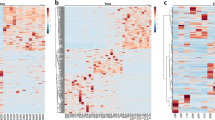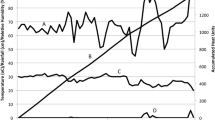Abstract
Body-associated microbes were recently shown to change significantly during decomposition, undergoing an ecological succession in experimental conditions using rodent and swine models. We investigated microbial succession in soils associated with swine carcasses under experimental field conditions in summer and winter. We demonstrate that these postmortem microbial communities change in a specific, reproducible fashion, and that soil microbes represent a significant component of the postmortem microbial community, contrary to widespread belief in forensic science. However, the effects of decomposition on soil microbial communities were different in summer and winter. We suggest that the microbial ecological succession will be useful in medicolegal death investigation; however, observations in winter might not be applicable to summer, which indicates a need for a greater understanding of the seasonality of decomposition.


Similar content being viewed by others
References
Metcalf J, Wegener-Parfrey L, Gonzalez A, Lauber CL, Knights D, Ackermann G, et al. A microbial clock provides an accurate estimate of the postmortem interval in a mouse model system. eLife. 2013;2:e01104.
Pechal JL, Crippen TL, Benbow ME, Tarone AM, Dowd S, Tomberlin JK. The potential use of bacterial community succession in forensics as described by high throughput metagenomic sequencing. Int J Leg Med. 2014;128:193–205.
Hyde ER, Haarmann DP, Lynne AM, Bucheli SR, Pertrosino JF. The living dead: bacterial community structure of a cadaver at the onset and end of the bloat stage of decomposition. PLoS One. 2013;8:e77733.
Pechal JL, Crippen TL, Tarone AM, Lewis AJ, Tomberlin JK, Benbow ME. Microbial community functional change during vertebrate carrion decomposition. PLoS One. 2013;8:e79035.
Vass AA. The elusive universal post-mortem interval formula. Forensic Sci Int. 2011;204:34–40.
Carter DO, Yellowlees D, Tibbett M. Cadaver decomposition in terrestrial ecosystems. Naturwissenschaften. 2007;94:12–24.
Carter DO, Yellowlees D, Tibbett M. Temperature affects microbial decomposition of cadavers (Rattus rattus) in contrasting soils. Appl Soil Ecol. 2008;40:129–37.
Carter DO, Yellowlees D, Tibbett M. Moisture can be the dominant environmental parameter governing cadaver decomposition in soil. Forensic Sci Int. 2010;200:60–6.
Meyer J, Anderson B, Carter DO. Seasonal variation of carcass decomposition and gravesoil chemistry in a cold (Dfa) climate. J Forensic Sci. 2013;58:1175–82.
Benbow ME, Lewis AJ, Tomberlin JK, Pechal JL. Seasonal necrophagous insect community assembly during vertebrate carrion decomposition. J Med Entomol. 2013;50:440–50.
Peel MC, Finlayson BL, McMahon TA. Updated world map of the Köppen–Geiger climate classification. Hydrol Earth Syst Sci. 2007;11:1633–44.
Caporaso JG, Kuczynski J, Stombaugh J, Bittinger K, Bushman FD, Costello EK, et al. QIIME allows analysis of high-throughput community sequencing data. Nat Methods. 2010;7:335–6.
Putman RJ. Patterns of carbon dioxide evolution from decaying carrion. 1. Decomposition of small mammal carrion in temperate systems. Oikos. 1978;31:47–57.
Putman RJ. Flow of energy and organic matter from a carcase during decomposition. 2. Decomposition of small mammal carrion in temperate systems. Oikos. 1978;31:58–68.
Lauber CL, Metcalf JL, Keepers K, Ackermann G, Carter DO, Knight R. Vertebrate decomposition is accelerated by soil microbes. Appl Environ Microbiol. 2014;80:4920–9.
Evans WED. The chemistry of death. Springfield: Charles C. Thomas; 1963.
Fierer N, Ladau J, Clemente JC, Leff JW, Owens SM, Pollard KS, et al. Reconstructing the microbial diversity and function of pre-agricultural tallgrass prairie soils in the United States. Science. 2013;6158:621–4.
Bongers T, Ferris H. Nematode community structure as a bioindicator in environmental sampling. Trends Ecol Evol. 1999;14:224–8.
Tibbett M, Carter DO. Mushrooms and taphonomy: the fungi that mark woodland graves. Mycologist. 2003;17:20–4.
Sagara N, Yamanaka T, Tibbett M. Soil fungi associated with graves and latrines: toward a forensic mycology. In: Tibbett M, Carter DO, editors. Soil analysis in forensic taphonomy: chemical and biological effects of buried human remains. Boca Raton: CRC Press; 2008. p. 67–108.
Acknowledgments
DNA sequences have been deposited in the QIIME database as studies 1609. We thank J Huntley and the CU next-generation sequencing facility. We thank Allison Mann for assistance with sequence data processing. This work was supported in part by the National Institute of Justice (Award 2011-DN-BX-K533) and the Howard Hughes Medical Institute. NIH-BRIC P20MD006084 supports research capacity and infrastructure at Chaminade University of Honolulu.
Author information
Authors and Affiliations
Corresponding author
Additional information
David O. Carter and Jessica L. Metcalf contributed equally to this study.
Rights and permissions
About this article
Cite this article
Carter, D.O., Metcalf, J.L., Bibat, A. et al. Seasonal variation of postmortem microbial communities. Forensic Sci Med Pathol 11, 202–207 (2015). https://doi.org/10.1007/s12024-015-9667-7
Accepted:
Published:
Issue Date:
DOI: https://doi.org/10.1007/s12024-015-9667-7




